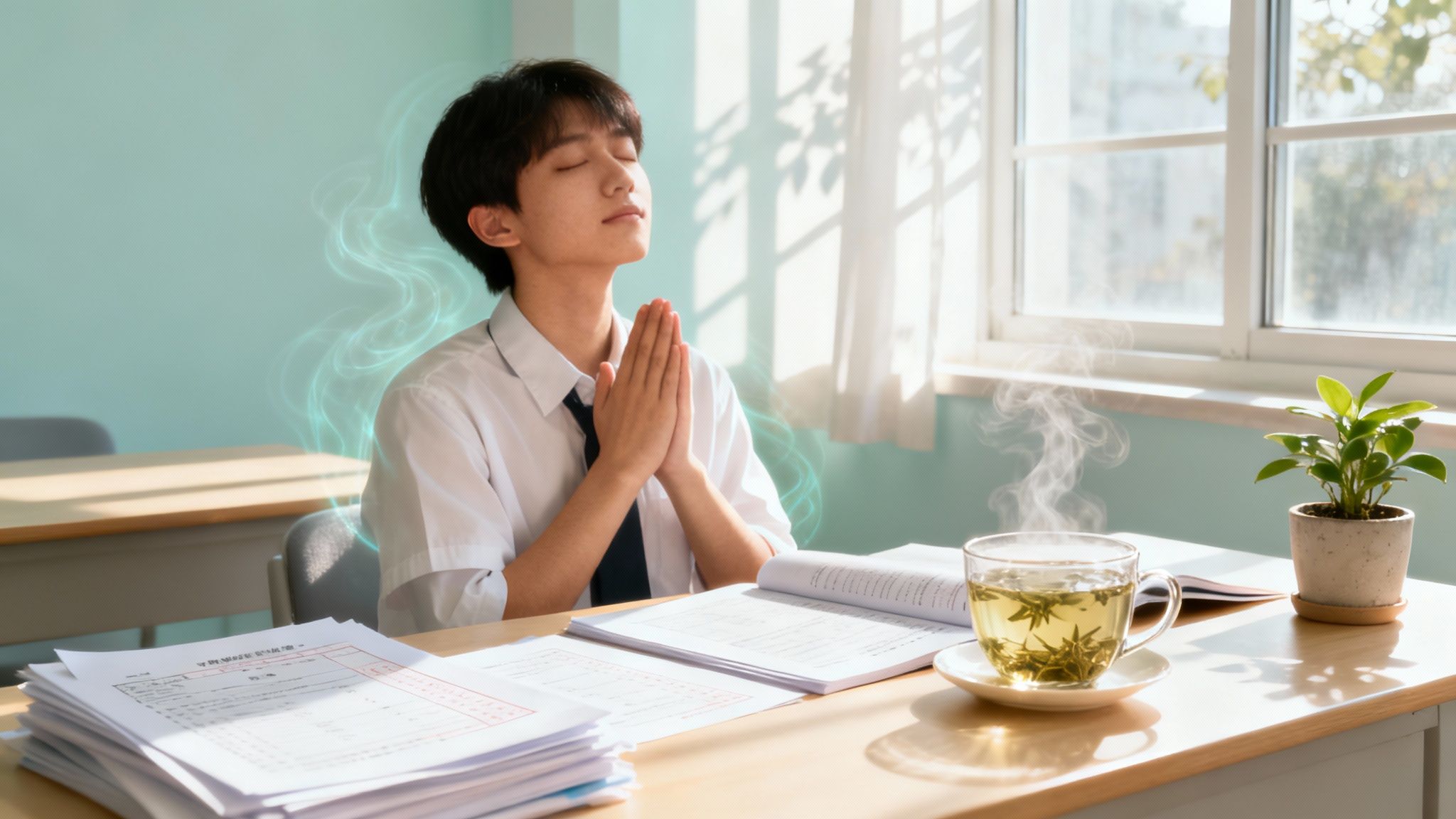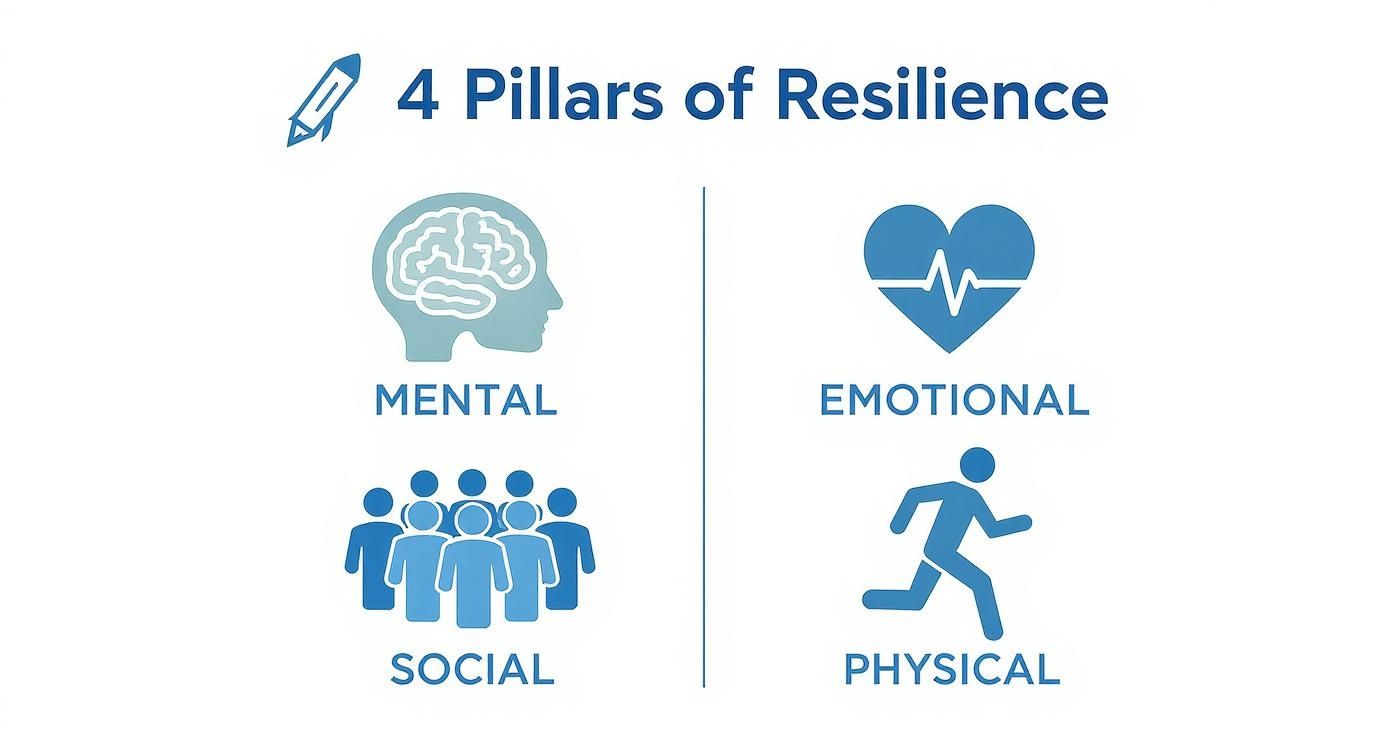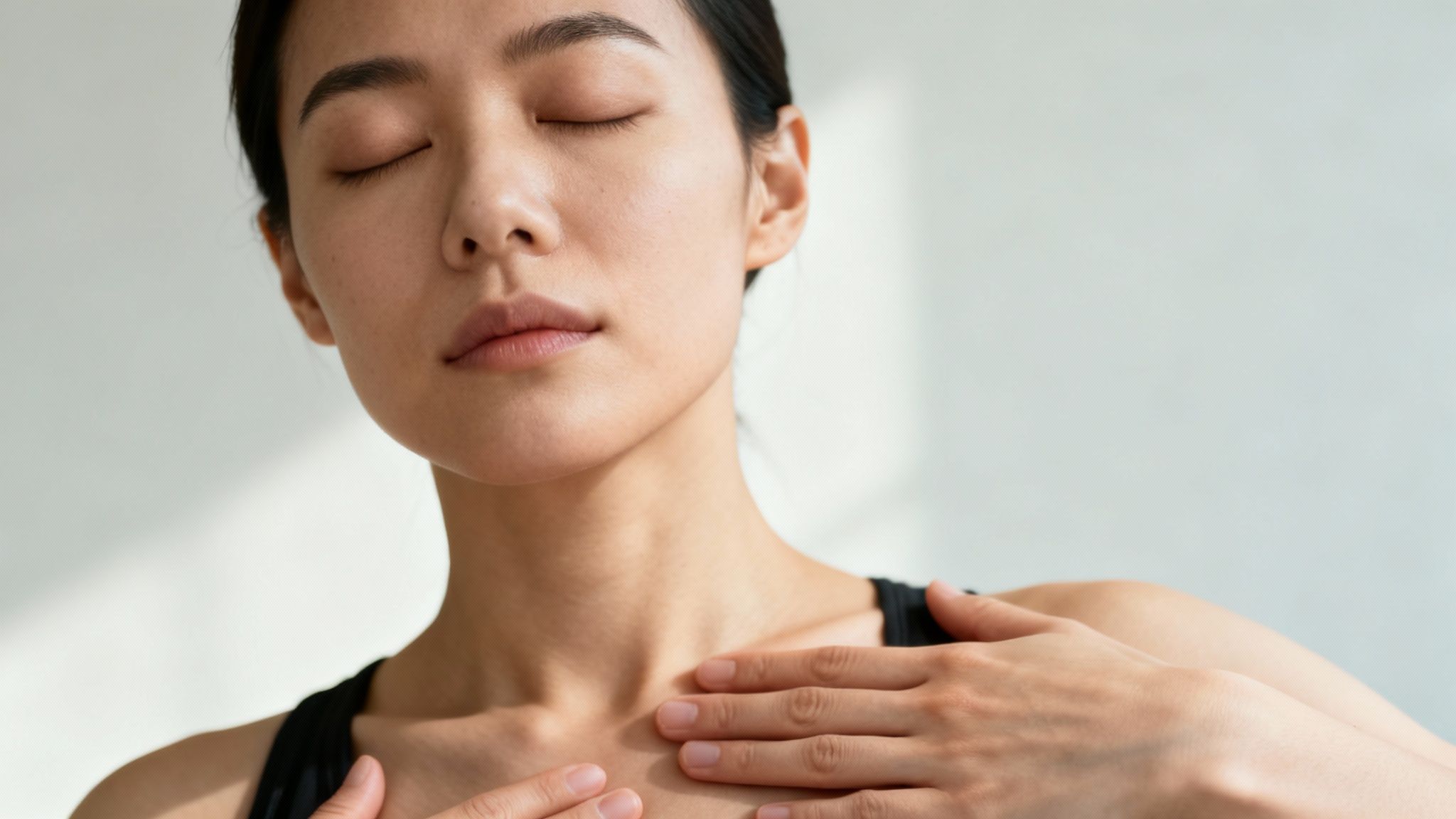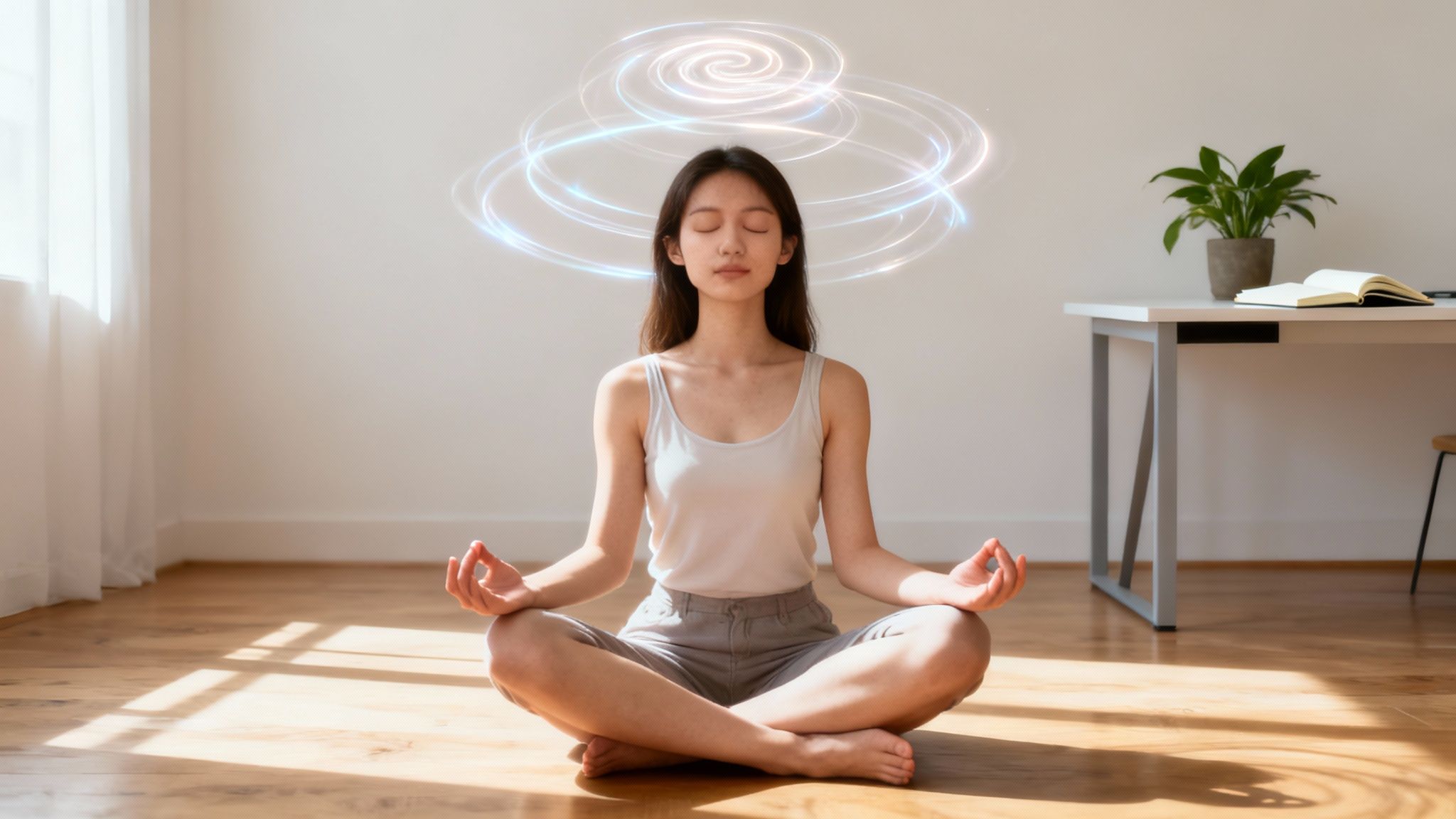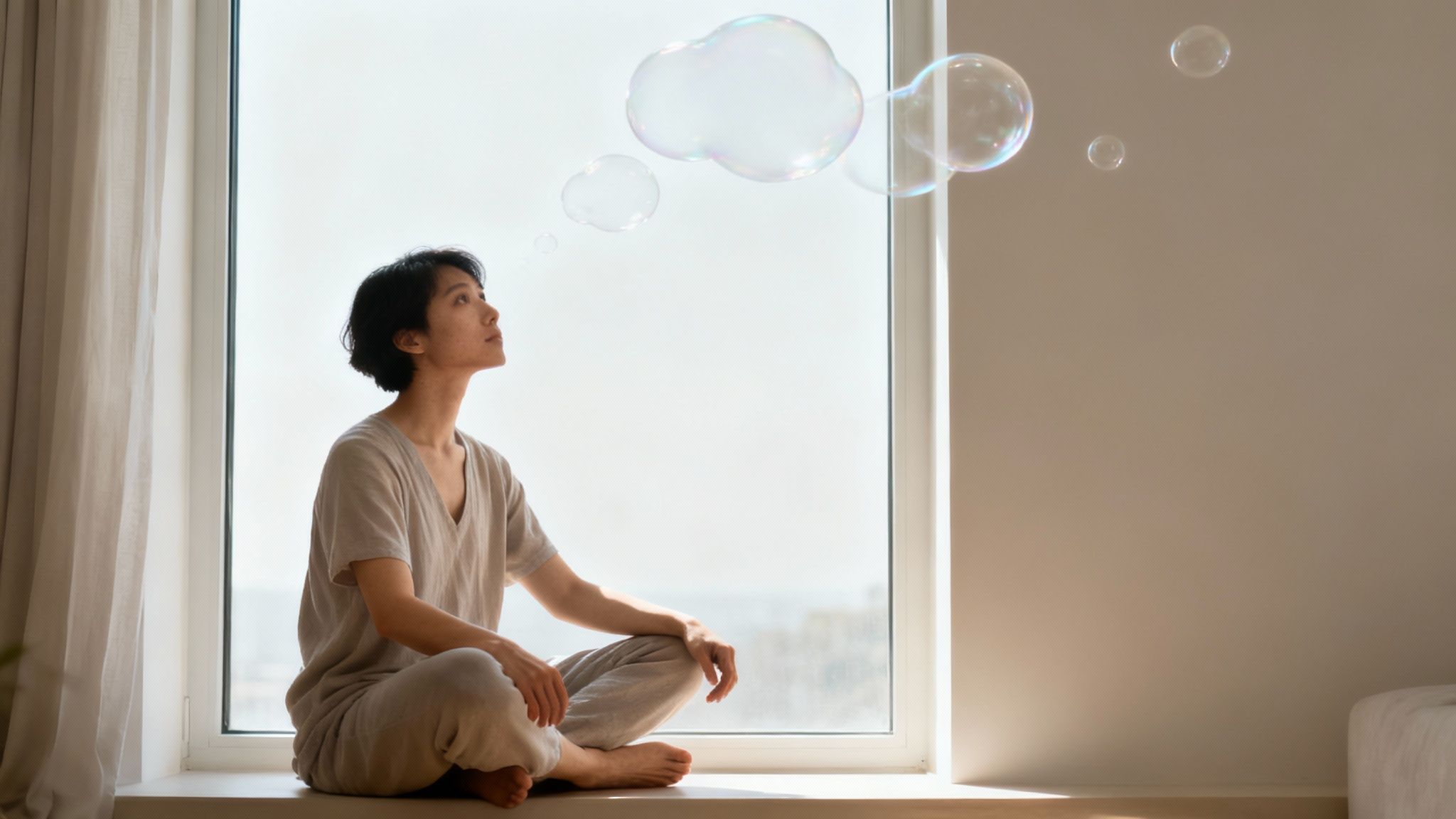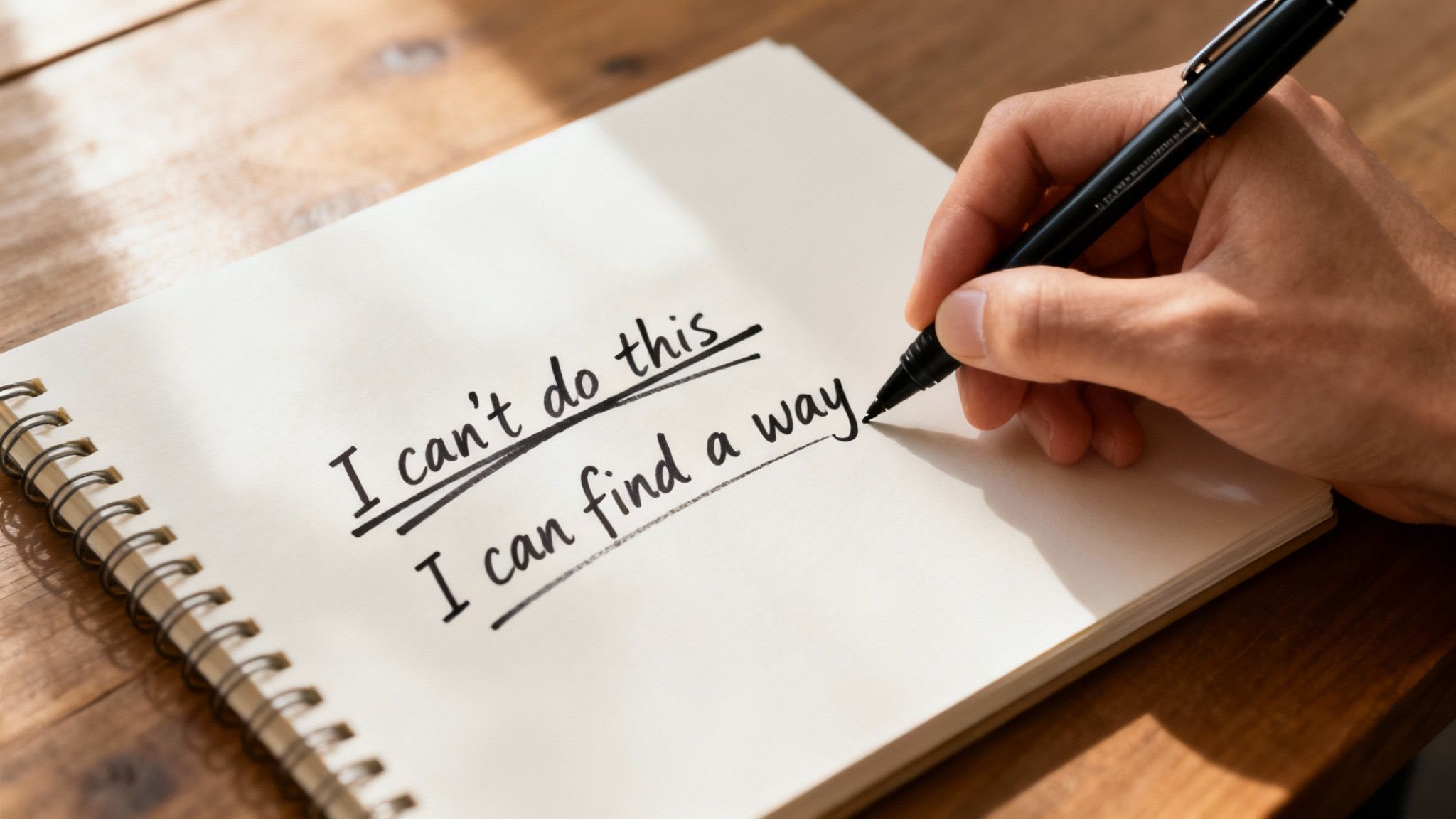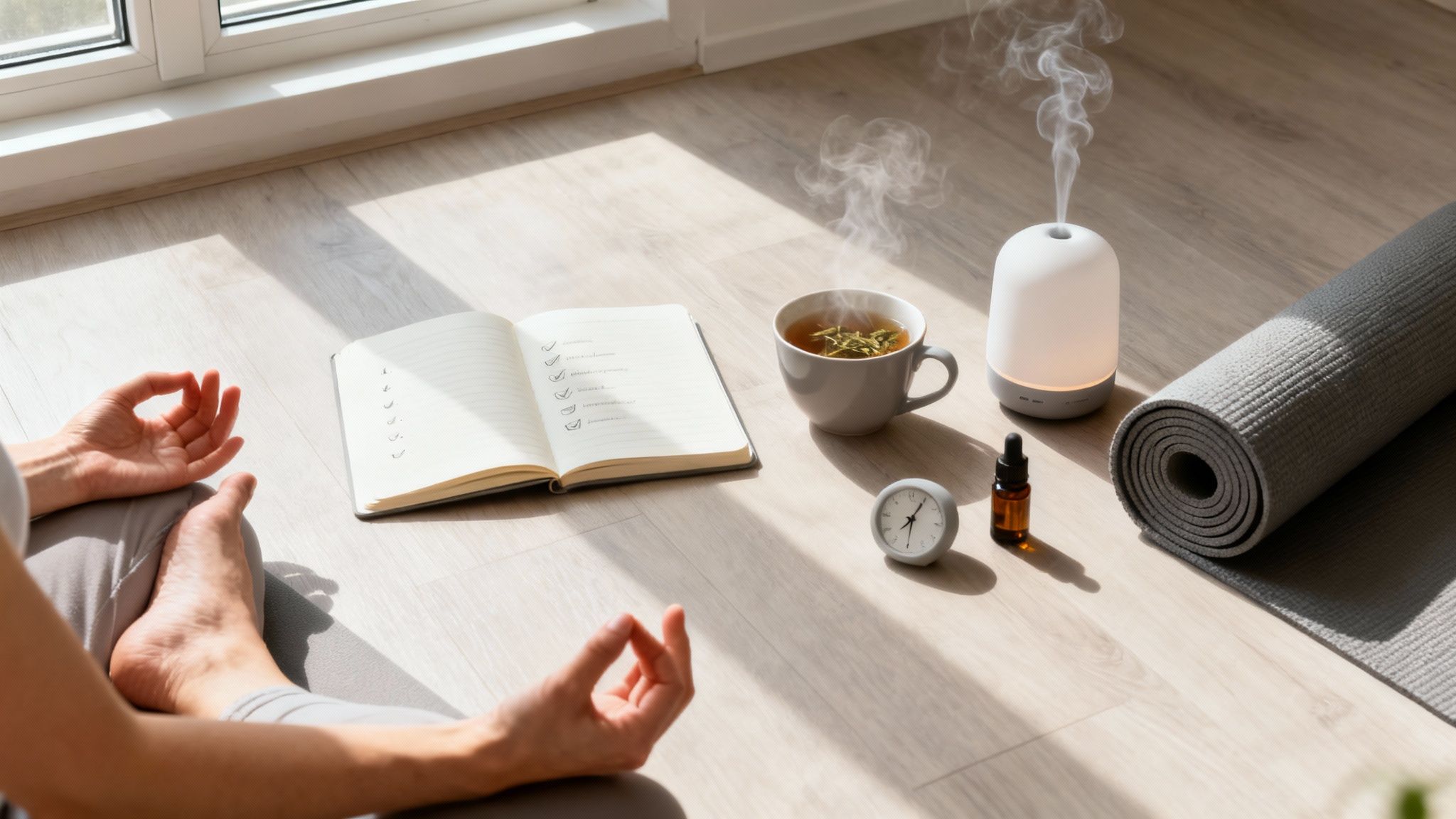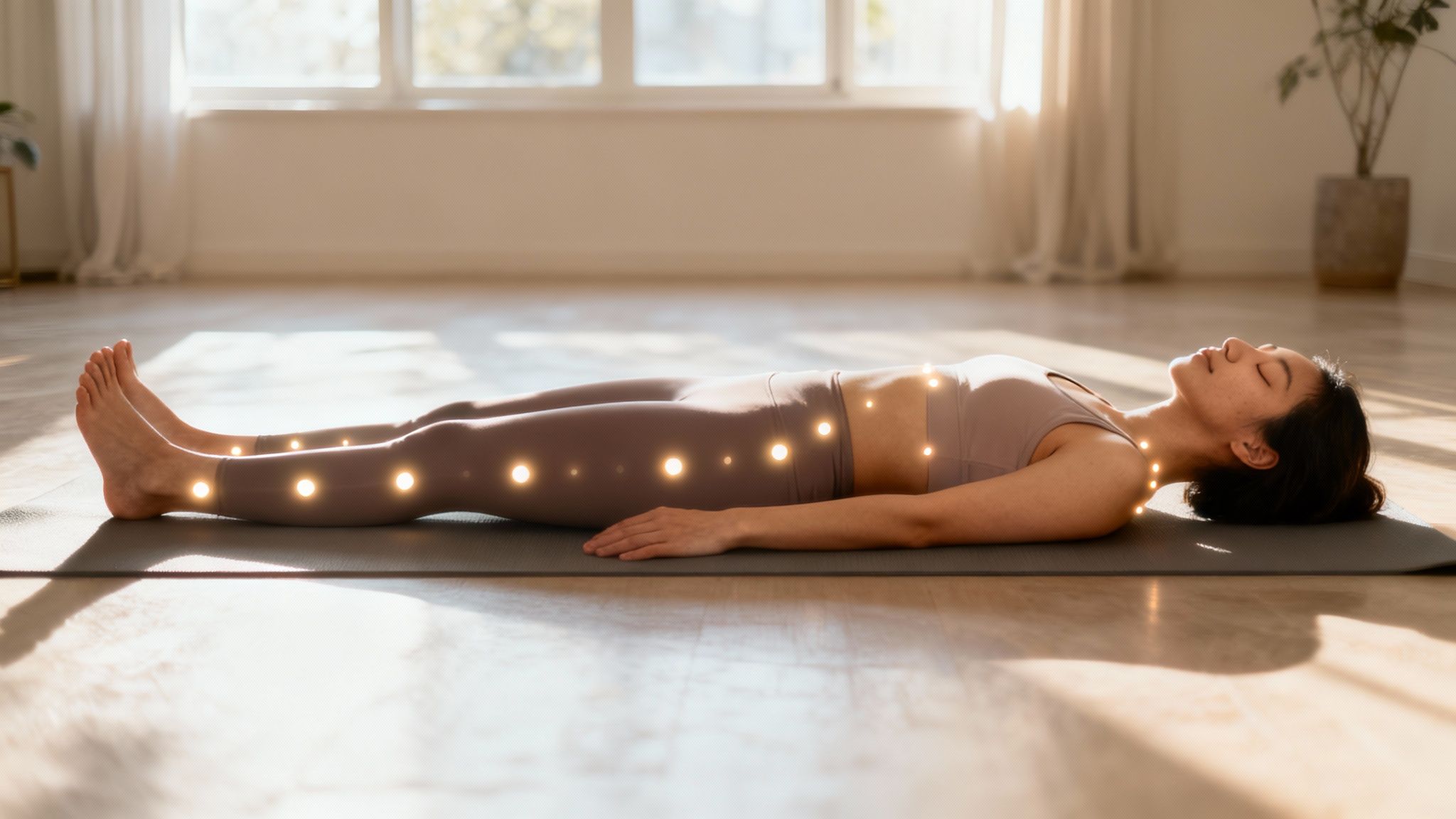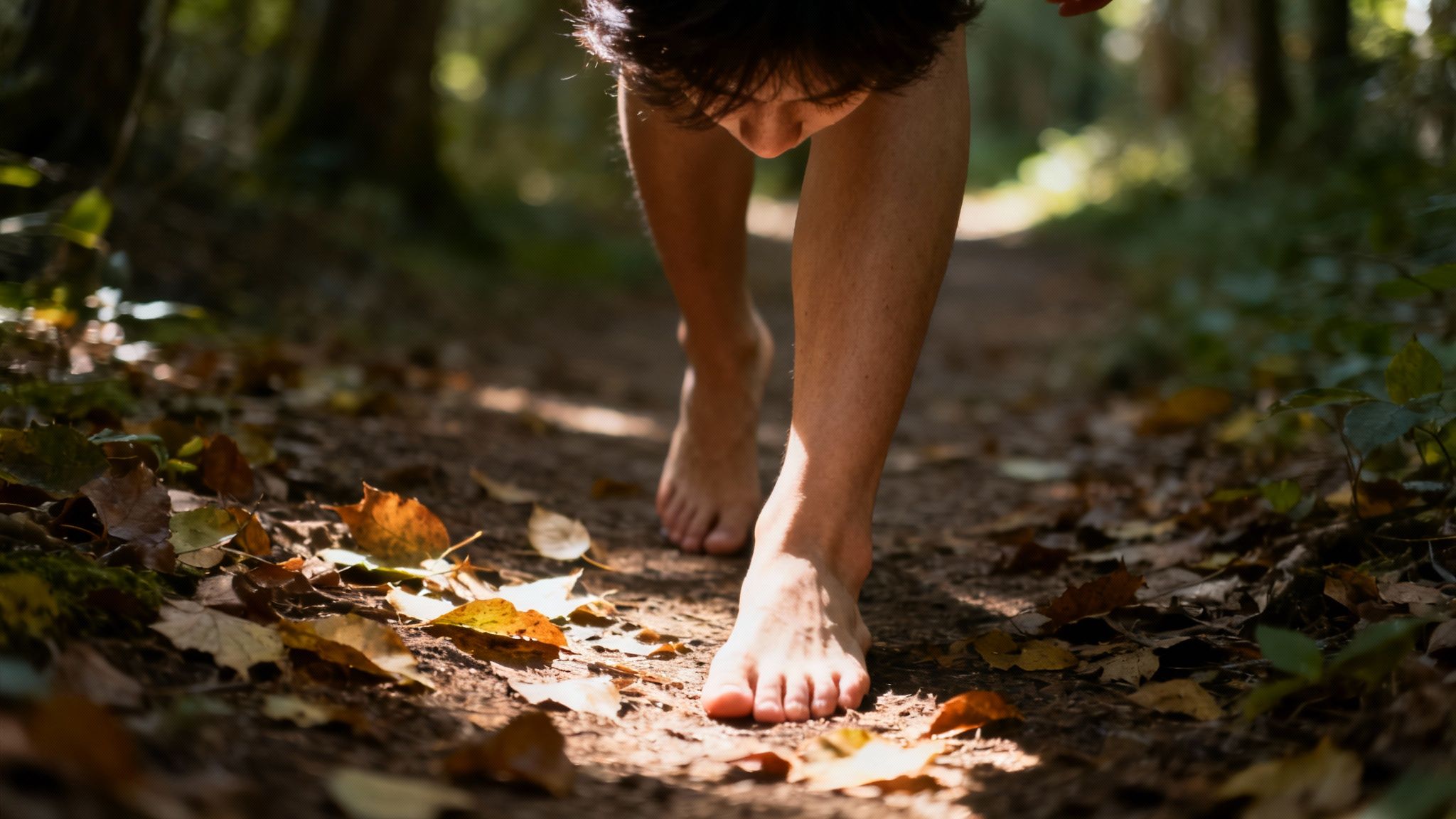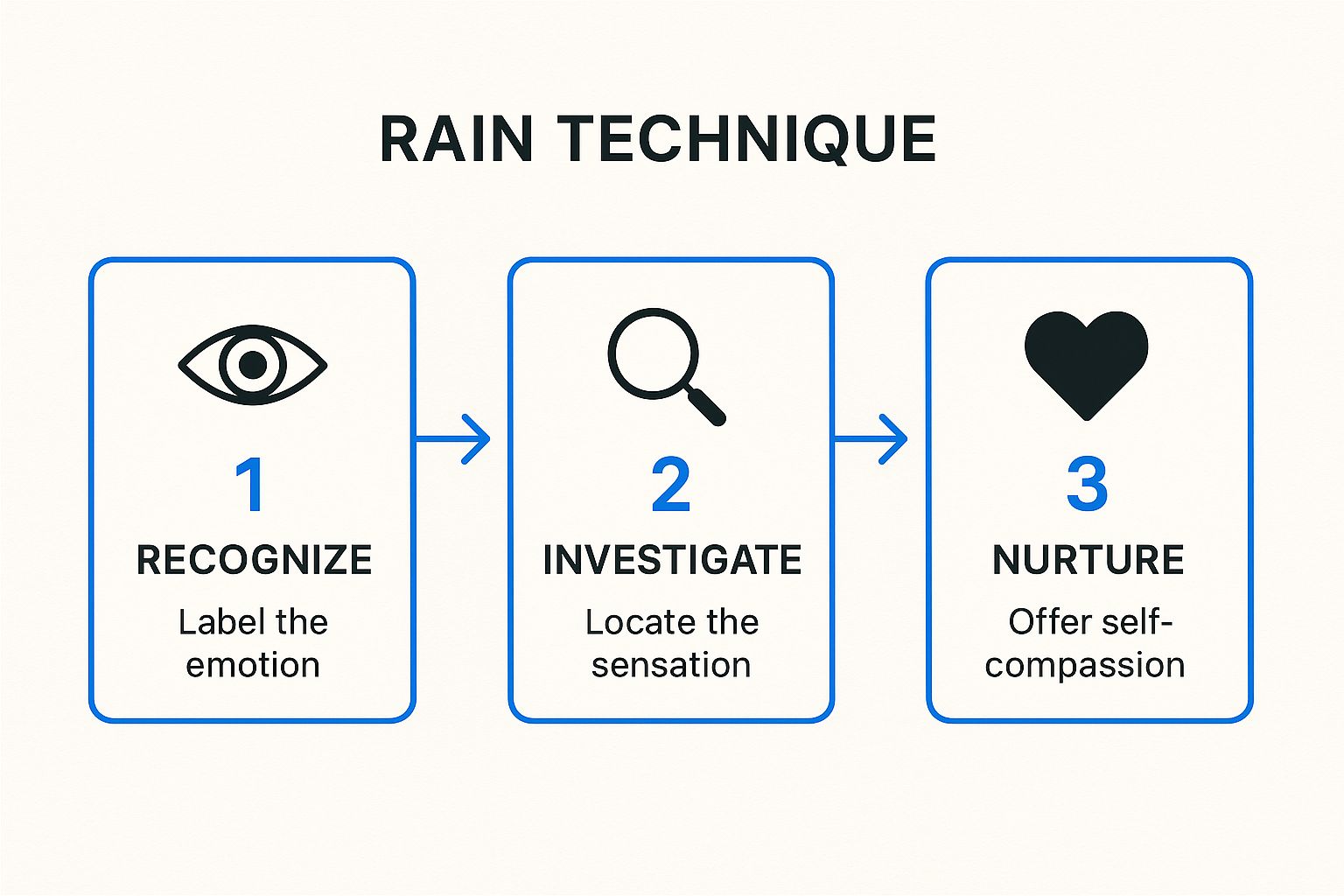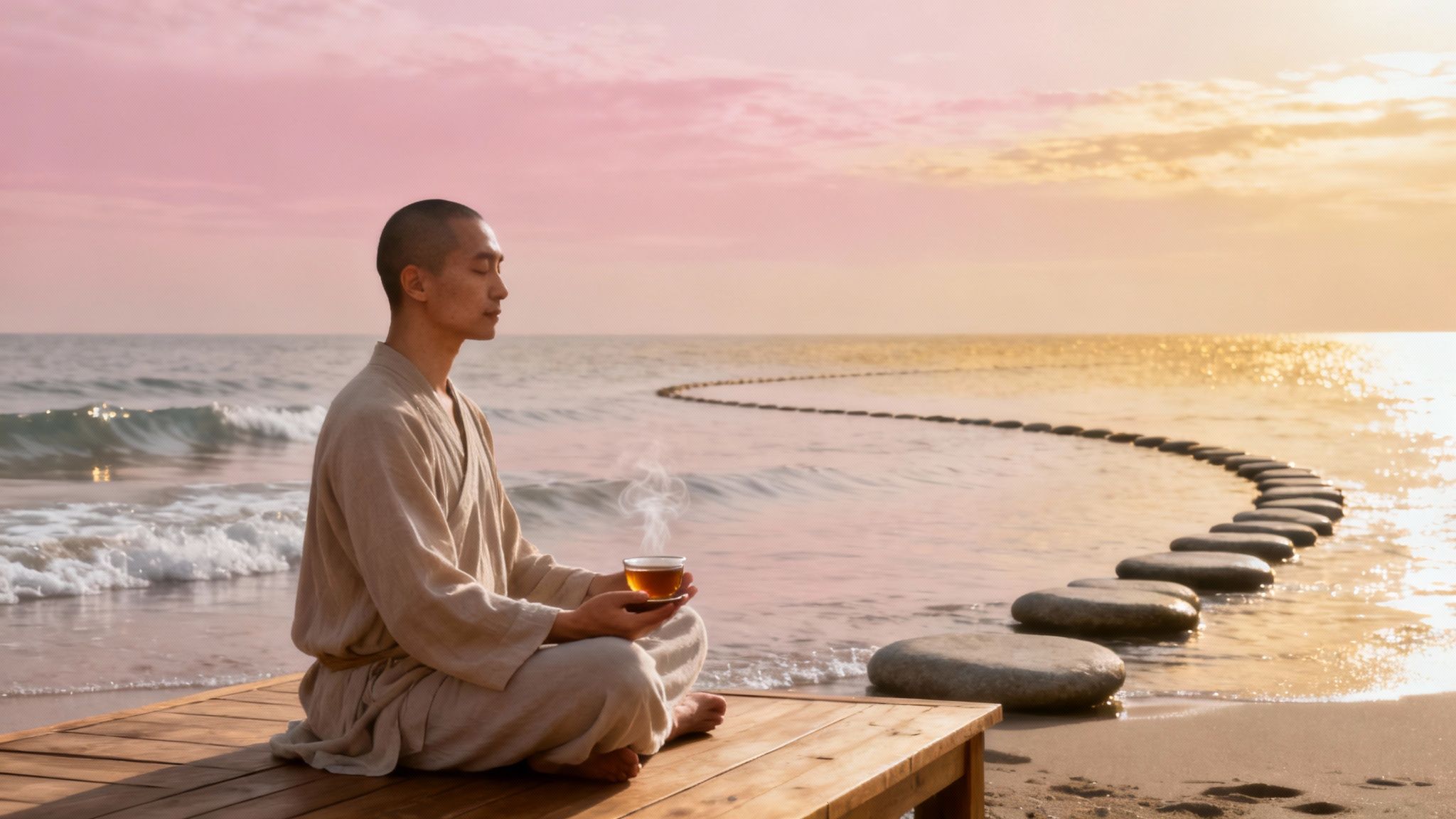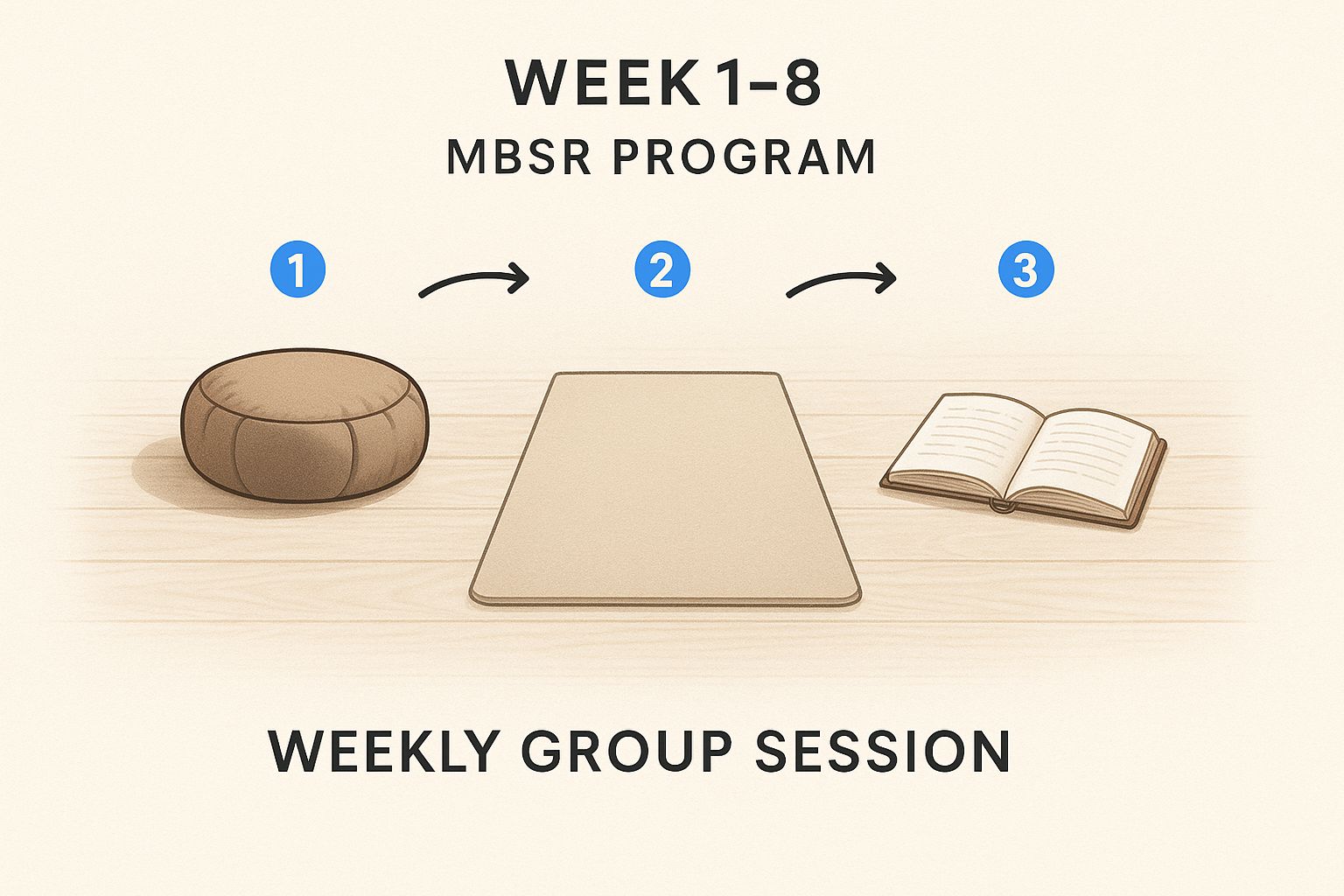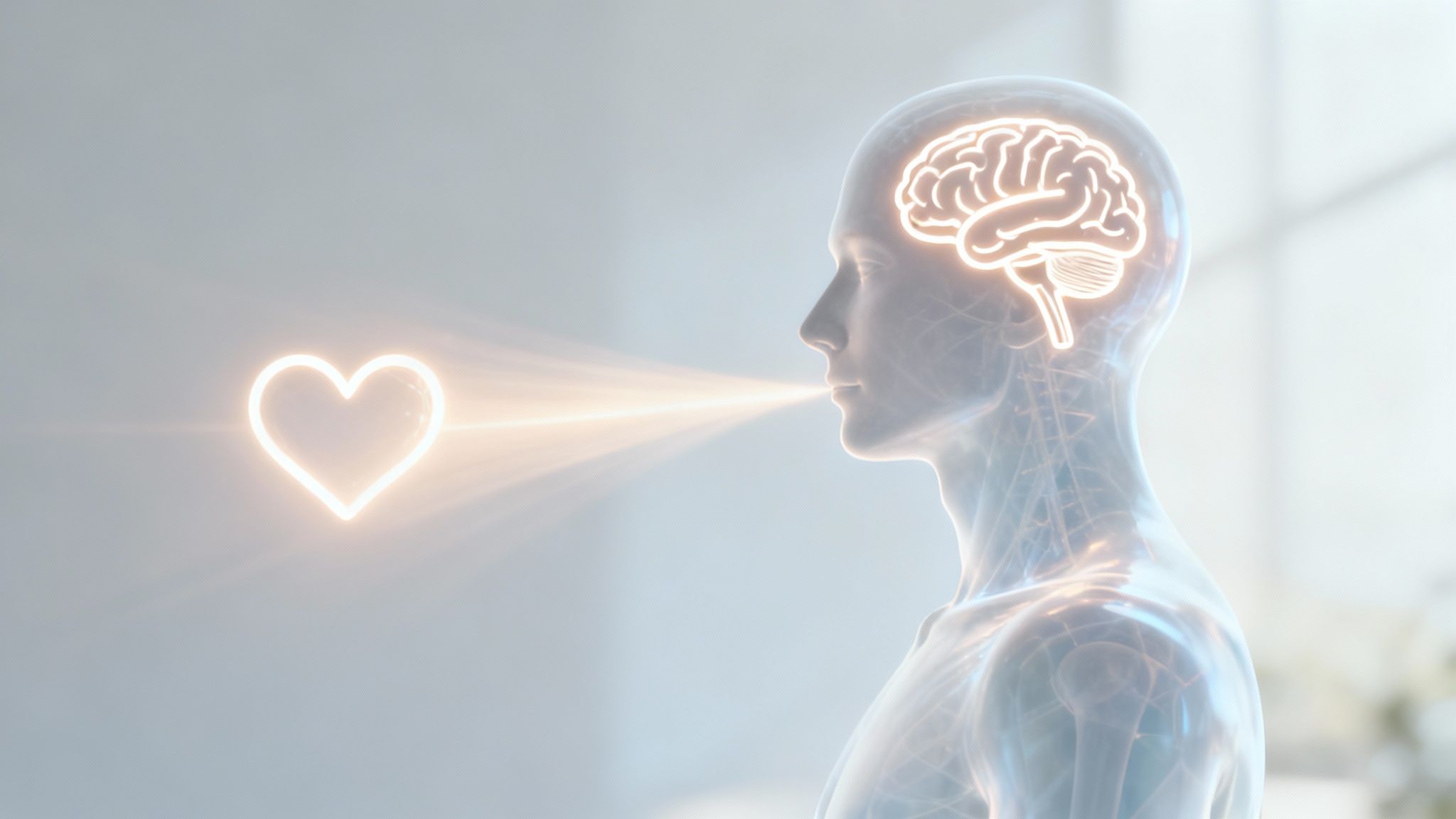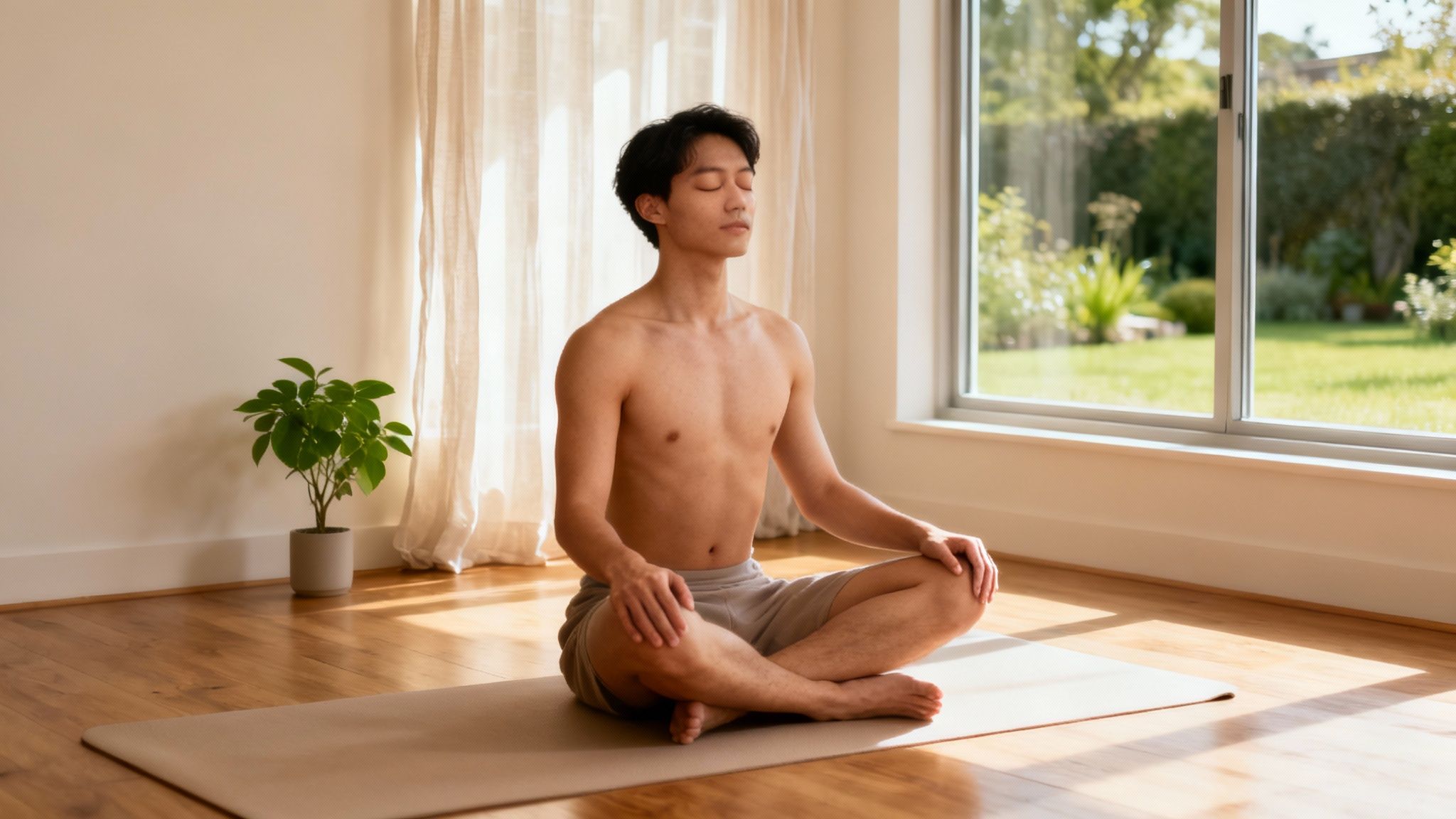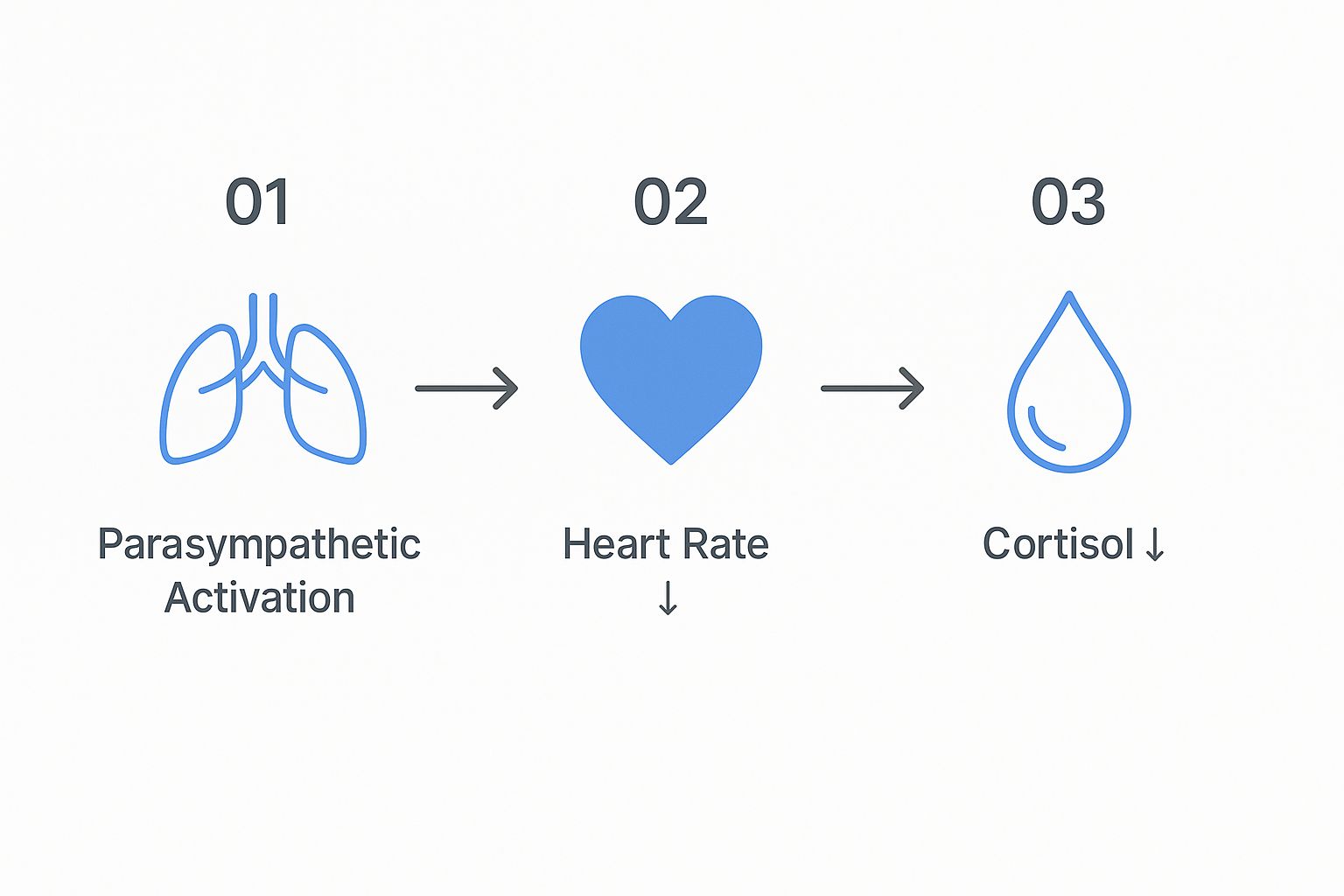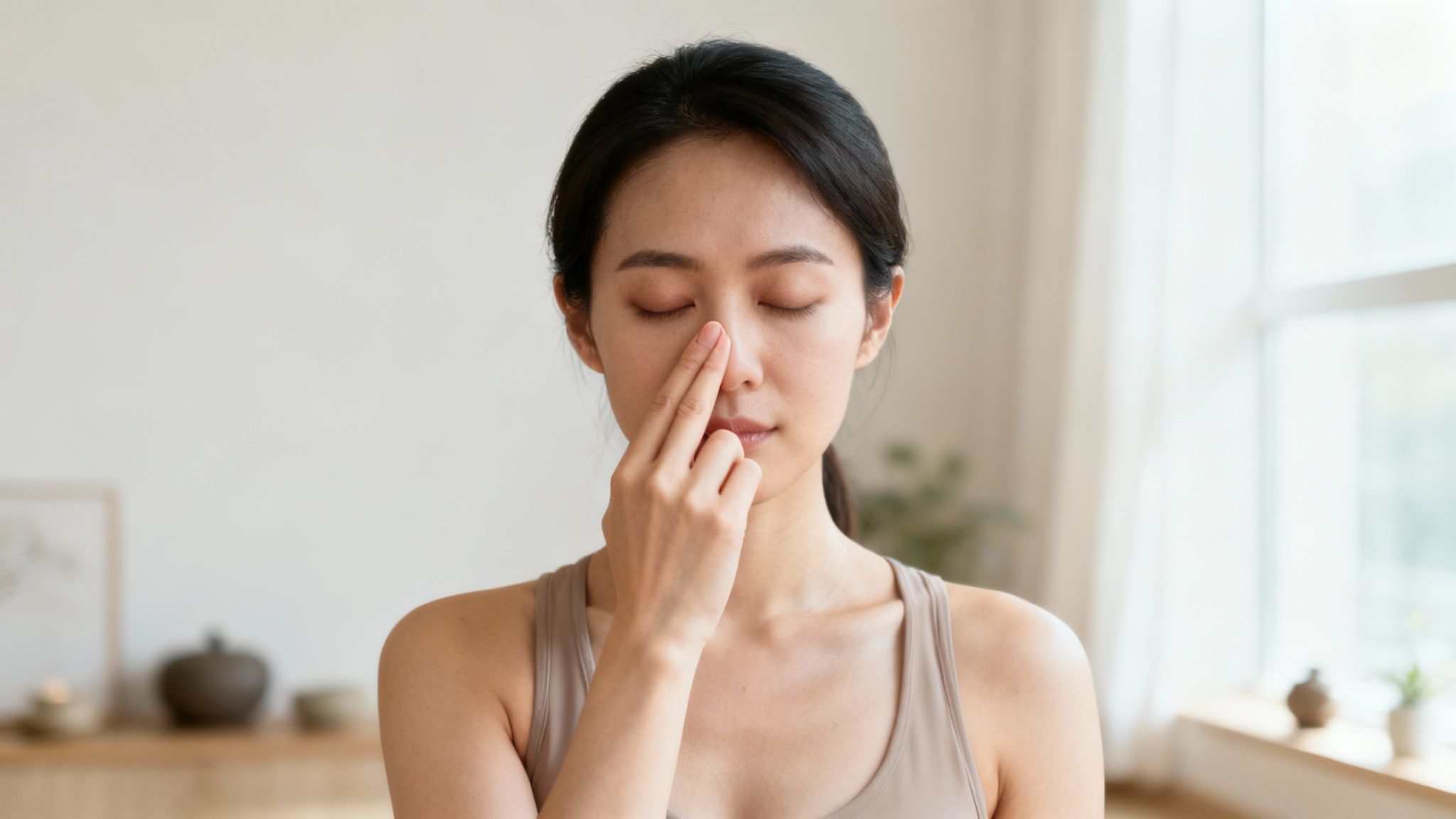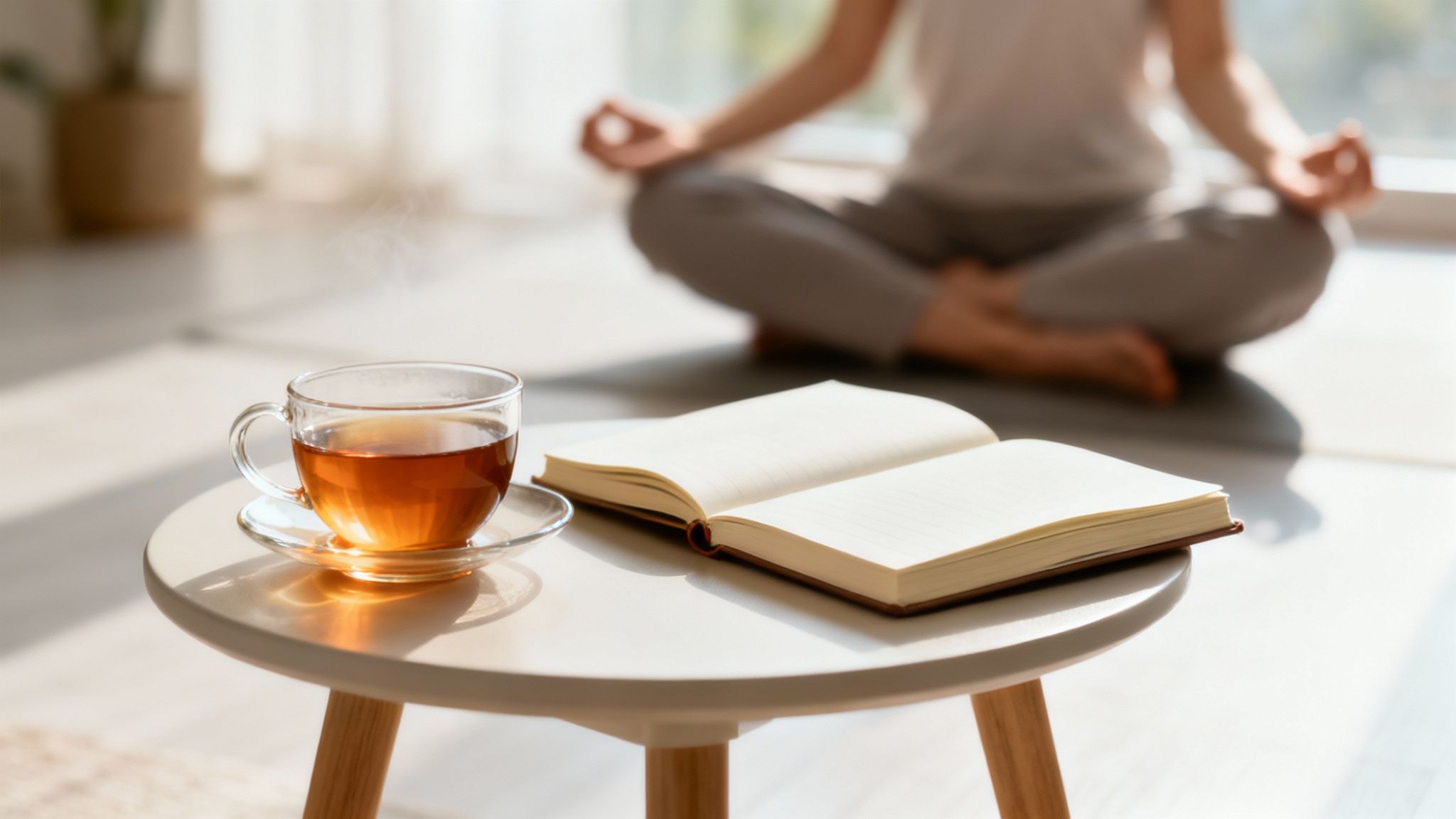Tackling exam anxiety isn't about finding a single magic solution. It's about combining smart preparation, a healthier mindset, and some practical, in-the-moment calming tricks. The best way to get ahead of it is to start building your resilience long before you see the exam paper.
This guide will help you create a plan that works for you. You'll learn to challenge nagging negative thoughts and make your well-being a top priority.
Why Exam Nerves Can Feel So Overwhelming
Feeling nervous before a big exam is completely normal. In fact, a little bit of that stress can sharpen your focus and push you to prepare properly. But sometimes, that gentle flutter of nerves can grow into something much bigger and more disruptive.
When pre-test jitters escalate into persistent worry, physical unease, and a loop of negative thoughts, you might be dealing with exam anxiety. This is a specific type of performance anxiety where the pressure feels immense. In today's competitive world, it's a very common experience for students everywhere.
Recognising the Signs of Exam Anxiety
The first step to managing exam anxiety is learning to recognise what it looks and feels like. The signs can show up differently for everyone. Usually, it's a mix of physical sensations, racing thoughts, and even changes in how you act.
These are your body's natural reactions to what it sees as a major threat. Being able to spot these signs without judgment is key for building resilience and finding what helps you stay grounded.
| Symptom Category | Common Examples |
|---|---|
| Physical | Racing heart, sweaty palms, headaches, upset stomach, shallow breathing, muscle tension. |
| Cognitive | Mind going blank, trouble concentrating, negative self-talk ("I'm going to fail"), racing thoughts. |
| Emotional | Feeling irritable or on edge, a looming sense of dread, overwhelming frustration, a sudden drop in confidence. |
| Behavioural | Procrastinating or avoiding studying, trouble sleeping, fidgeting, changes in eating habits. |
Please remember, this table is for informational purposes only and is not a diagnostic tool. Seeing these symptoms can simply help you realise that you're having a legitimate response to stress.
The Indian Context: A Shared Challenge
In India, the pressure to perform well in exams is woven into our academic culture. Fierce competition for university spots and top careers creates an environment where the stakes feel sky-high. This naturally increases feelings of stress and anxiety, making it a shared societal challenge.
This pressure has a real impact on student well-being, with data showing a significant emotional toll. You can discover more insights about these student mental health statistics for a deeper understanding of this complex issue.
Acknowledging this context helps us remember that these feelings are not a personal failing. They are a valid response to a demanding system, which is the first step toward self-compassion.
Realising you aren’t alone can be a powerful antidote to the isolation that anxiety often brings. It opens the door to asking for support, whether that means seeking professional counselling or talking with friends. This helps reframe anxiety as a signal that you need more tools and support to protect your well-being.
Building Your Pre-Exam Resilience Plan
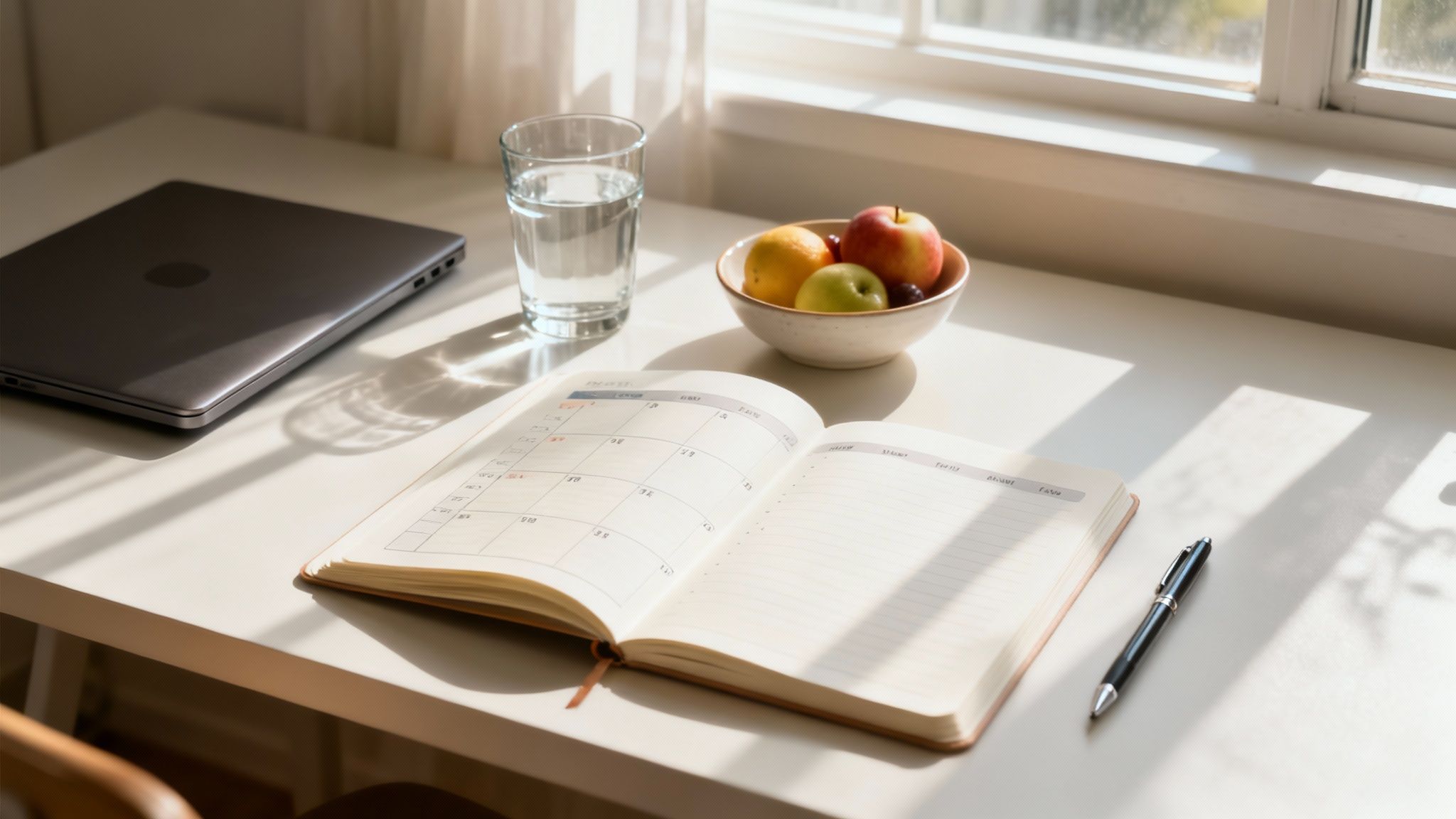
The best way to handle exam anxiety starts long before the test day. It begins by building a strong foundation of resilience that prepares your mind and body for the pressure.
Think of it like training for a marathon; you wouldn't just show up and hope for the best. Building a solid pre-exam routine creates sustainable habits that boost your confidence and your general well-being.
Craft a Study Schedule That Works for You
One of the biggest triggers for exam anxiety is feeling overwhelmed by a mountain of material. A good study plan breaks that mountain into manageable chunks. The secret is to build a schedule that’s realistic for you.
Schedule your most challenging subjects for when you're sharpest. A great plan isn't just about what you study; it’s about making the process feel achievable.
Here are a few tips to make your schedule effective:
- Break it down: Instead of "Study Physics," try "Revise Chapter 3 and solve 10 practice problems." This turns a huge task into a clear goal.
- Schedule your breaks: Your brain needs downtime. Pencil in short breaks every hour and longer ones for meals to avoid burnout.
- Be flexible: Life happens. Build some buffer time into your week so an unexpected event won’t derail your entire plan.
The Power of Lifestyle Habits
You can’t pour from an empty cup. Simple things like what you eat, how much you sleep, and how often you move have a huge impact on your ability to manage stress. When your body is cared for, your mind is better equipped to handle pressure.
Consistent sleep is non-negotiable, as it helps with memory and mood, making you less vulnerable to anxiety and even depression. Likewise, a balanced diet provides the steady fuel your brain needs for concentration.
These aren't just extras; they are the pillars of your resilience plan. Prioritising sleep and nutrition is a powerful act of self-compassion during a stressful time.
Challenging the Negative Inner Voice
A huge part of exam anxiety is the stories we tell ourselves, like "You're going to fail." That inner critic can feel incredibly convincing. Learning to challenge these automatic negative thoughts is a game-changing skill for life, especially for managing future workplace stress.
Start by noticing these thoughts without judgment. When one pops up, ask yourself: Is this thought 100% true? You could reframe "I'm going to fail" to "I've prepared for this, and I'll do my best."
This technique, called cognitive reframing, is a cornerstone of professional therapy and counselling for anxiety. It puts you back in the driver's seat of your mind, helping you build calm, confidence, and personal happiness.
Calm Your Mind with In-the-Moment Techniques
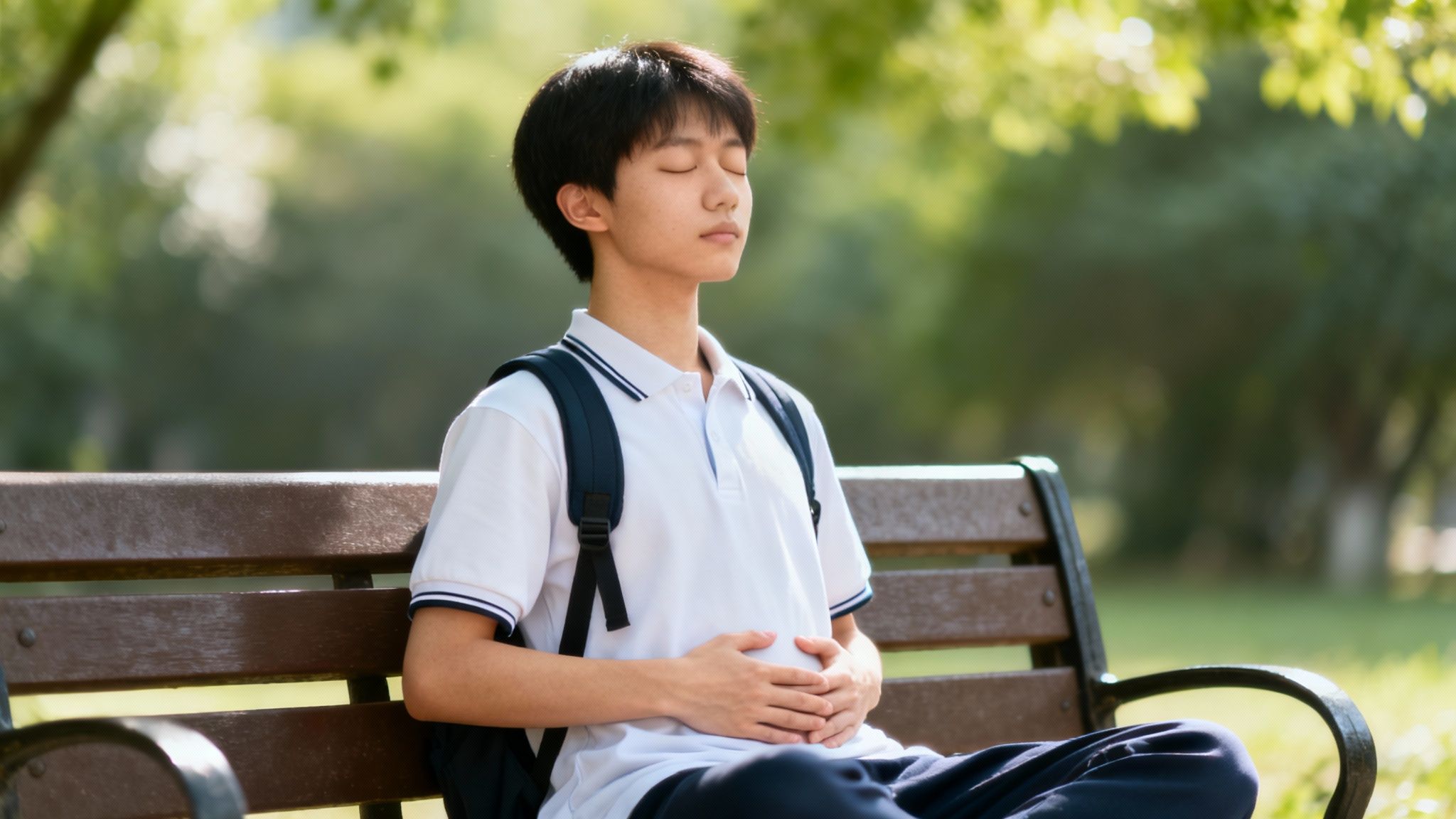
When your heart races just before an exam, you need practical, fast-acting tools. These techniques are like a mental first-aid kit. The goal isn't to erase anxiety but to get the physical symptoms under control so you can think clearly again.
Learning to ground yourself pulls you out of a panic spiral. It lets the prepared, rational part of your brain take over.
The Power of Your Breath
One of the quickest ways to dial down a spike in anxiety is to focus on your breathing. When we get stressed, our breathing becomes shallow and rapid. By intentionally slowing it down, you send a powerful message of safety to your body.
A simple and discreet technique is box breathing. You can do it anywhere without anyone noticing.
Here’s how you do it:
- Breathe in slowly for a count of four.
- Gently hold your breath for a count of four.
- Breathe out slowly for a count of four.
- Hold again for a count of four.
Repeat this cycle a few times. This tiny action can make a huge difference in slowing a racing heart and is a core skill for building real-time resilience.
Ground Yourself with the 5-4-3-2-1 Method
When anxiety makes your thoughts chaotic, grounding techniques are your anchor. They pull your focus into the physical world. The 5-4-3-2-1 method engages your senses, forcing your brain to concentrate on the here-and-now.
Pause and silently identify:
- Five things you can see (a poster, your pen, a crack on the floor).
- Four things you can feel (your chair, the texture of your clothes).
- Three things you can hear (distant footsteps, your own breathing).
- Two things you can smell (the scent of a book, your cup of tea).
- One thing you can taste (a mint, or just the taste of your own mouth).
This exercise instantly interrupts the panic cycle. It’s an incredibly practical way to manage that overwhelming feeling.
Small Comforts for Big Moments
Sometimes, the simplest sensory comforts can make a real difference. A small, comforting routine can signal to your brain that it’s time to calm down. For example, sipping on a warm, non-caffeinated drink can be incredibly soothing.
If you're looking for ideas, you could explore various teas that relax body and mind. These little acts of self-care are crucial parts of your well-being toolkit.
Staying Focused Inside the Exam Room

You can prepare for weeks, but panic can still hit you in the exam hall. The ticking clock and rustling papers can be peak moments for exam anxiety. What you do in these critical hours is just as important as your revision.
The goal is to shift your brain from fear to focus. With a few smart tactics, you can keep your cool and show what you know.
Your First Five Minutes Matter
How you start the exam sets the tone. Don't dive into the first question immediately. Take a moment to ground yourself as a strategic move for your well-being and final mark.
Before you write your name, take three slow, deep breaths to calm your nervous system. Next, quickly scan the whole paper to get a feel for the layout and identify the questions you feel good about.
Build Momentum Strategically
We've all experienced "going blank" on the first question, which can trigger a spiral of self-doubt. You can sidestep this trap with a smarter approach.
Instead of tackling questions in order, find the ones you know you can answer easily. This builds a powerful sense of confidence and quiets that anxious voice. This makes it much easier to face tougher questions with a clear head.
Think of each easy question as a small victory. This approach transforms the exam from a single obstacle into a series of manageable steps.
Regain Control with Discreet Grounding
If panic bubbles up halfway through, you need a quiet way to get back in control. A simple grounding exercise is perfect for this.
Here’s a quick technique you can do at your desk:
- Press your feet firmly into the floor and feel the solid ground.
- Grip your pen tightly for a few seconds, then relax your hand.
- Focus on your breathing for a moment, just observing the air move in and out.
These tiny physical acts pull your attention back to the present, short-circuiting the panic cycle. Learning this now will also help you handle future workplace stress with more resilience.
The Power of Positive Self-Talk
The conversation in your head during an exam can make or break your performance. Negative thoughts like "I can't do this" fuel anxiety and feelings of depression.
If you hit a wall, don't panic. Tell yourself, "Okay, I'll circle back to this one," and remind yourself of the work you put in: "I am prepared." This is about giving yourself the same encouragement you'd give a friend.
To sharpen your performance, you can explore strategies to improve focus while studying. Building a distraction-proof environment is a huge part of dealing with exam anxiety.
Handling the Aftermath: Post-Exam Stress and Self-Criticism
The exam might be over, but the anxiety often isn't. The time spent waiting for results can be just as nerve-wracking. It’s easy to get caught in a loop of replaying every answer and second-guessing every choice.
Learning to manage this post-exam period is a huge part of building lasting resilience. This skill will serve you well beyond academia, especially when dealing with workplace stress.
Sidestep the "Exam Post-Mortem"
You know the scene after an exam when everyone dissects every question. While it feels necessary to join in, these conversations often do more harm than good. Hearing someone took a different approach can send you into a spiral of self-doubt over something you can no longer control.
Politely walk away from these discussions. Your energy is better spent relaxing and recharging. Acknowledge that you did your best in that moment and let it be.
You cannot control the outcome now, but you can control how you treat yourself while you wait. Choose kindness over criticism as a powerful act of self-care.
Give Yourself a Bit of Grace
Our default response to a potential mistake is often to beat ourselves up. But would you ever talk to a friend that way? Treating yourself with the same kindness is a much healthier way to process the experience.
Self-compassion isn't about making excuses; it's about acknowledging that you tried your best and that exams are difficult. This simple shift can stop anxiety from spiralling into something more serious, like depression.
Here are a few ways to show yourself compassion:
- Name the feeling: Simply telling yourself, "It's normal to feel anxious waiting for results," can take away much of its power.
- Focus on effort, not outcome: Give yourself credit for the hours you put in, regardless of the final mark.
- Plan a reward: Give yourself something to look forward to, like a movie night or a day out with friends. This shifts your focus from worry to positive anticipation.
Reframe the Exam: It's a Tool, Not a Verdict
It’s easy to see an exam as the final word on your intelligence. A more powerful perspective is to view it as a snapshot of your understanding at one point in time. It's just data that provides feedback on your strengths and areas for improvement.
This mindset is key to building academic and professional resilience. Even a disappointing result becomes a learning opportunity, not a failure. If the stress ever feels like too much, remember that talking to a professional through counselling or therapy is a sign of strength.
Knowing When to Reach Out for Support
While self-help strategies are powerful, sometimes they aren't enough. Deciding to reach out for professional support is not a sign of weakness. It's a brave, proactive step toward protecting your mental well-being.
The real skill is recognising when anxiety has tipped over from manageable jitters into something more persistent. You don't have to carry that burden alone.
Signs It Might Be Time to Talk to Someone
It can be tough to draw a line between normal stress and something needing more support. A good rule of thumb is this: if exam anxiety is negatively affecting your life outside of studying, it might be time to chat with a professional.
Think of these signs as gentle prompts to check in with how you're really feeling.
Consider reaching out if you notice:
- A persistent low mood: You've felt down, hopeless, or irritable most of the time, and the feeling doesn't lift after the exam.
- Significant changes in your habits: Your sleep patterns or appetite have dramatically shifted.
- Social withdrawal: You find yourself pulling away from friends, family, and activities you used to enjoy.
- Physical symptoms that won't quit: You're dealing with constant headaches or stomach problems not tied to a physical illness.
These signals can indicate that stress is deepening into something more serious, perhaps touching on depression or a more generalised anxiety.
Please note: The assessments and tools you may find online are great for self-reflection and gaining insight. However, they are informational and are not a substitute for a professional diagnosis from a qualified expert.
Demystifying Therapy and Counselling
The thought of starting therapy or counselling can feel daunting. Modern therapy is usually a warm, collaborative conversation in a safe, confidential space. You can unpack what’s on your mind with someone trained to listen and guide you.
A therapist can help you uncover the root causes of your fears and negative thought patterns. They can also help you create personalised coping strategies and build lasting resilience to handle future academic and workplace stress.
Academic pressure in India is immense, with studies showing that many students report high levels of test anxiety. For example, some research indicates high rates of depression, anxiety, and stress among students preparing for competitive exams. You can discover more insights about these exam anxiety statistics.
This data shows how common these feelings are. Seeking help is a logical, healthy response and a powerful investment in your long-term happiness and success.
Final Takeaways
When you're in the thick of exam season, it's natural for questions and worries to pop up. Here are some supportive takeaways to keep in mind.
Is It Normal to Feel Anxious Before an Exam?
Yes, it’s completely normal to feel pressure before an exam. A little stress can sharpen your focus. The challenge arises when normal jitters become overwhelming anxiety that interferes with your preparation or performance.
The goal isn't to eliminate stress but to learn to manage it. This is how you build resilience, working with your body's alert system instead of letting it take over.
Can My Diet and Sleep Really Affect My Exam Anxiety?
Absolutely. Your physical and mental health are directly linked. Skimping on sleep can make anxiety feel worse, while a diet high in sugar and caffeine can amplify nervousness.
Aiming for 7-9 hours of quality sleep and eating balanced meals gives your mind and body a stable foundation to handle stress. These are fundamental pillars for good mental well-being.
Remember, these daily choices are powerful acts of self-compassion. Caring for your body is one of the most practical ways to prepare your mind for academic challenges.
What if These Techniques Don’t Work for Me?
It’s completely okay if some strategies don’t click for you. Managing anxiety is a personal process with no one-size-fits-all solution. The goal is to experiment and discover the tools that fit your unique needs.
If you’ve tried these techniques and still feel overwhelmed, reaching out for support through therapy or counselling is a sign of strength. It’s a proactive step toward taking control of your well-being, not a failure.
Ready to take the next step in understanding and managing your mental well-being? DeTalks offers confidential, science-backed assessments and can connect you with qualified therapists who are ready to help. Explore your options and find the right support for you.
